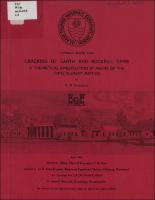Please use this identifier to cite or link to this item:
https://hdl.handle.net/11681/20511| Title: | Cracking of earth and rockfill dams : a theoretical investigation by means of the finite element method |
| Authors: | Harvard University Covarrubias, Sergio W. |
| Keywords: | Earth dams Embankment cracking Finite element method Rockfill dams Dam failures Design |
| Publisher: | U.S. Army Engineer Waterways Experiment Station. Engineer Research and Development Center (U.S.) |
| Description: | Technical Note Purpose: The principal purpose of this study was to investigate by means of the finite element method (1.) the effect of the shape of abutments, (2.) the effect of compressibility of the foundation, and (3.) the effect of zoning of dams on the development of tension cracks in earth and rockfill dams. All materials were assumed to be linearly elastic, with equa properties in tension and in compression. The only load considered was the weight of the embankment, and it was assumed to be applied in a single lift. These assumptions exaggerate the development of tension zones and, therefore, are considered to be justified for the purposes of this investigation. Comparison of the results of finite element analyses of four dams which have cracked, or in which large tension zones have developed, with the observed performance of these dams, has demonstrated good agreement between the theoretical results and the observations. Detailed investigation by means of the finite element method included sixteen longitudinal and fourteen transverse cross sections of idealized dams and the above-mentioned four case records. These analyses showed that by application of the finite element method it is indeed possible to locate zones within dams where tension cracks are likely to develop. The agreement between the observed and computed tension zones and the distribution of longitudinal strains along the crest was found to be reasonably good. The numerous cases investigated and presented in this thesis show that by means of the finite element method it is possible to quickly gain an insight into the variables which affect the development of tension zones and to select a type of design and construction procedures which will minimize cracking. It is concluded that the finite element method, coupled with the theory of elasticity, is a useful approach for assessing the relative merits of design features with respect to the development of tension cracks in dams. |
| Rights: | Approved for public release; distribution is unlimited. |
| URI: | http://hdl.handle.net/11681/20511 |
| Appears in Collections: | Contract Report |
Files in This Item:
| File | Description | Size | Format | |
|---|---|---|---|---|
| CR-S-69-5.pdf | 16.34 MB | Adobe PDF |  View/Open |